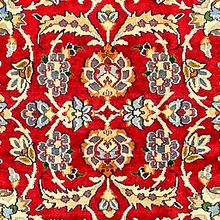Shahreza Rug
| Shahreza Rug | |
|---|---|
 Design of Shahreza Rug (Rugman) | |
| General information | |
| Name | Shahreza Rug |
| Original name | قالی شهرضا |
| Alternative name(s) | Shahreza Carpet (Ghomsheh Rug) |
| Origin | |
| Category | City, Village |
| Technical information | |
| Common designs | Medallion, Mihrab, Shah Abbasi, Islimi |
| Common colors | Red, Blue, Navy Blue, Green, White |
| Dyeing method | Natural, Synthetic |
| Pile material | Wool |
| Foundation material | Cotton |
| Knot type | Asyemmetrical (Persian) |
Shahreza rugs originate from Shahreza, located in the central western region of Iran, in the Province of Isfahan, and enjoys a long and illustrious history of weaving Persian carpets. Originally known as Qomshen, it was renamed Shahreza when a holy figure named Imamzadeh Shahreza was buried there. Shahreza is well known for its exquisite tightly knotted Persian carpets woven using the asymmetrical Persian knot.
History
Shahreza is a city located on the road between Isfahan and Shiraz in the Isfahan Province of central Iran. Shahreza rugs are known in the rug trade from as early as the first quarter of the twentieth century. The rugs were made for domestic use and are generally woven in identical pairs in design and color. After being used in the household domestically for approximately ten to twenty-five years, Shahreza rugs are then resold in the bazaars for foreign export.
Shahreza weavings are floral and have designs that reflect the traditional Isfahan Shah Abbas style. The rugs are in allover or medallion designs. The colors have a vivid appearance, with reddish-brown, beige, or dark blue for the field, borders, and medallion. Shades of brown, green, blue, gold, gray, and cinnamon accentuate the flowers and other design elements.
Most Shahrezas are approximately seven feet by four feet six inches in size, but a few can be found measuring closer to five feet by three feet. Some examples of small room sizes can also be found in the old carpet market. The weavings have a cotton foundation and a wool pile tied with Persian (asymmetric) knots. They range from medium to good in grade quality.
By the late twentieth century, many Shahreza weavers switched from local traditional designs to make rugs similar to those of other Iranian weaving regions in accordance with domestic and foreign consumer demand.[1]
See also
| Search for Shahreza Rug on Wikipedia. |
References
- ↑ Moheban, 2015, 523-524
Bibliography
- Abraham Levi Moheban. 2015. The Encyclopedia of Antique Carpets: Twenty-Five Centuries of Weaving. NewYork: Princeton Architectural Press.